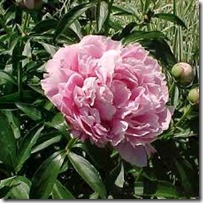Growing from slender, vertical tubers, herbaceous peonies (Paeonia spp.) are long-lived perennials that resent root disturbance. Thus, gardeners carefully select the planting site and prepare the soil for long-term cultivation. While peonies display somewhat attractive, deeply lobed leaves, their real ornamentation is the mid to late spring flowers. Improper planting and unsatisfactory growing conditions cause peonies to reduce flowering or cease altogether.
Site Selection
-
Ample sunshine is needed to bring peonies into flower.
To increase flowering or ensure it, plant peonies in the garden in full sun to partial shade locations that aren’t exposed to winds. In Canada and the northern United States where summers are shorter and cooler, plant peonies where they receive no less than 6 hours of direct sunshine. In the southern U.S. where summers are long and hot and winters mildly cool, plant in partial sun to partial shade exposures. A garden site where 6 hours of direct sun occurs in the morning followed by dappled afternoon shade is perfect. Peonies are not well suited to the southern states that are warmer than U.S. Department of Agriculture plant hardiness zone 8a.
Proper Planting
-
Enrich planting soil with plenty of organic matter incorporated to a depth of 12 inches before planting any peony. A common error associated with planting or transplanting herbaceous peonies is planting too deeply. On the tuberous roots, there are small buds called eyes. These eyes mustn’t be covered with more than 2 inches of soil once planted. Peonies planted too deeply produce abundant foliage but fail to yield flowers. In addition, transplanting of bare root peonies is best done in the fall months. The first spring after transplanting, flowering may be diminished, but once the peony is established, flowering should be profuse the second year.
Growing Conditions
-
 Fernleaf peonies need growing conditions just like common herbaceous peony types.
Fernleaf peonies need growing conditions just like common herbaceous peony types.Established plantings and clumps of peonies may suffer reduced flowering if the soil becomes infertile, excessively dry or nutrient imbalanced. Overcrowding may also create these conditions because of an overabundance of roots in a limited amount of soil. Fertilizer applications that are rich in nitrogen promote leaf growth rather than flowering. Phosphorus and potassium is needed to encourage blooming. Keep the soil evenly moist in spring, and if peonies become crowded or shade each other’s leaves in summer, plan to thin out and transplant some plants in fall to remedy the situation.
Other Problems
-
 Ants do not harm peonies, they just drink the sweet nectar.
Ants do not harm peonies, they just drink the sweet nectar.Soil nematodes and thrips are two creature problems that may cause peonies to become weak or abort flower buds. According to Ron Smith of the North Dakota State University Extension Service, thrips can cause plump flower buds to shrivel and die. Peonies also have trouble flowering and growing in wet soil conditions. When over watered or if overcrowding reduces airflow and sunlight penetration to the plant base, stems of peonies may succumb to fungal diseases verticillium wilt or botrytis blight.


Deprecated: strpos(): Passing null to parameter #1 ($haystack) of type string is deprecated in /home/agriviek8Qv/agriviet.net/public_html/wp-includes/comment-template.php on line 2522